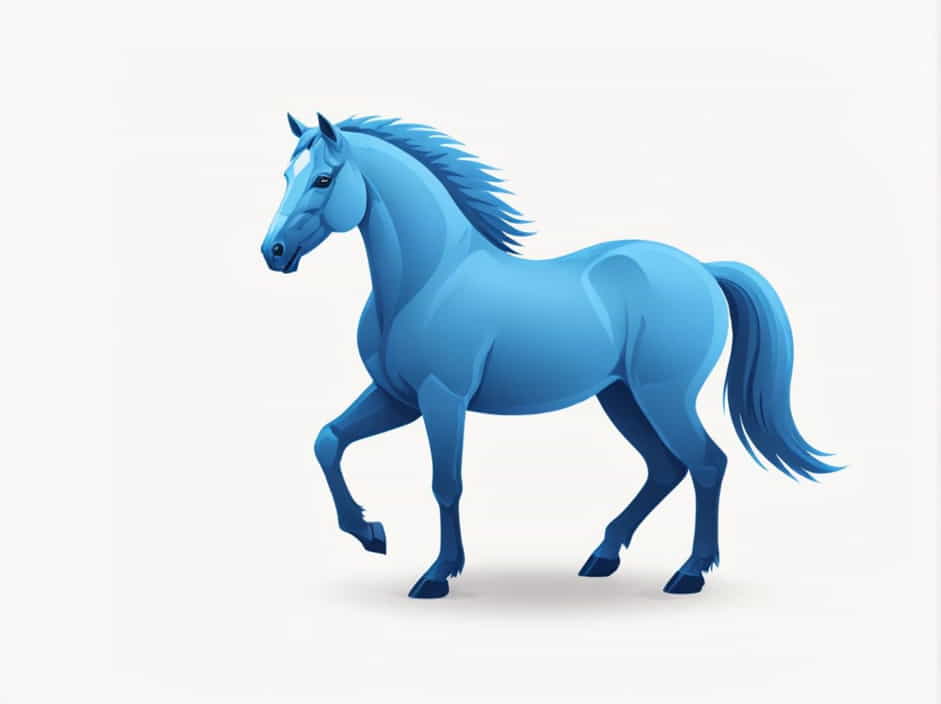Horses come in a wide variety of colors, but few are as striking as the blue roan. This distinctive coat pattern gives the horse a bluish appearance, making it highly sought after among equestrians and breeders. But what exactly is a blue roan horse? In this guide, we’ll explore its genetics, characteristics, breeds, and care requirements.
What Is a Blue Roan Horse?
A blue roan horse is a horse with a unique coat color resulting from a mix of black and white hairs evenly distributed across its body. This combination gives the horse a bluish-gray appearance. However, unlike gray horses, blue roans maintain their dark head, mane, tail, and lower legs throughout their life.
Key Characteristics of a Blue Roan Horse:
✅ Even mix of black and white hairs throughout the body
✅ Dark head, mane, tail, and legs (usually black)
✅ Coat does not lighten with age, unlike gray horses
✅ Color can change slightly with the seasons, appearing darker in winter and lighter in summer
The Genetics Behind the Blue Roan Color
The blue roan coat color is determined by a specific genetic combination. It results from the presence of the roan gene (Rn) combined with a black base coat. Here’s how it works:
- The roan gene (Rn) causes white hairs to be evenly mixed with the base coat color.
- A black base coat (E/E or E/e) is necessary to produce the blue roan effect.
- The horse’s mane, tail, and legs remain black because the roan gene only affects the body.
This means that not all black horses can be blue roans—they must inherit the roan gene from at least one parent.
How to Identify a Blue Roan Horse
It’s easy to confuse blue roans with other coat colors, especially gray or grullo horses. Here’s how to tell the difference:
Blue Roan vs. Gray Horse
| Feature | Blue Roan | Gray |
|---|---|---|
| Coat Changes with Age? | No | Yes (lightens over time) |
| Mane, Tail & Legs | Black | Often lightens to white or silver |
| Seasonal Color Variation | Yes | No |
Blue Roan vs. Grullo Horse
| Feature | Blue Roan | Grullo |
|---|---|---|
| Coat Color | Even mix of black & white hairs | Solid smoky or slate-colored coat |
| Mane, Tail & Legs | Always black | Black but can have faint stripes |
| Roan Gene Present? | Yes | No |
By examining these traits, you can accurately identify a true blue roan horse.
Breeds That Can Have Blue Roan Coloring
Not all horse breeds carry the roan gene, so blue roan horses are found only in certain breeds. Some of the most common include:
1. American Quarter Horse
The American Quarter Horse is one of the most popular breeds that carries the blue roan gene. It is known for its agility, speed, and versatility in ranch work and rodeo events.
2. American Paint Horse
Paint Horses can also carry the roan gene, producing stunning blue roan variations with unique white markings.
3. Percheron
This draft breed can occasionally produce blue roans, though they are rarer compared to other coat colors.
4. Tennessee Walking Horse
Known for their smooth gait, Tennessee Walkers sometimes exhibit blue roan coats, adding to their elegance.
5. Mustang
Wild Mustangs sometimes display the blue roan coat, making them even more striking in their natural environment.
How Blue Roan Horses Change with the Seasons
One interesting trait of blue roan horses is their seasonal color variation.
- Winter Coat: Blue roans often look darker in winter because their thicker coat makes black hairs more prominent.
- Summer Coat: As they shed their winter hair, the white hairs become more visible, making them look lighter or dustier in summer.
This change is natural and does not mean the horse is losing its roan coloring.
Caring for a Blue Roan Horse
Caring for a blue roan horse is similar to caring for any other horse, but their distinct coat color means they may require extra attention in some areas.
1. Grooming
Because their coat consists of dark and light hairs, dirt and dust can be more noticeable. Regular brushing and bathing will keep them looking clean and vibrant.
2. Sun Protection
Blue roans with lighter summer coats may be prone to sun bleaching, especially on their black mane and tail. Providing shade and using UV-protectant sprays can help maintain their rich color.
3. Health Maintenance
Like all horses, blue roans need regular hoof care, dental checkups, and vaccinations to stay healthy. Their coat color does not affect their overall health, but proper care is essential for their well-being.
Why Are Blue Roan Horses So Popular?
Blue roan horses are highly desired for several reasons:
✅ Rare and unique color – The striking contrast of black and white hairs makes them stand out.
✅ Attractive in competitions – Many horse owners prefer blue roans for shows and rodeos.
✅ Symbol of strength and beauty – Their bold appearance often symbolizes power and elegance.
Because of their rarity, blue roans can sometimes be more expensive than other coat colors, especially in breeds like the American Quarter Horse or Mustang.
The blue roan horse is one of the most fascinating and visually stunning coat colors in the equine world. Their unique blend of black and white hairs, combined with their dark head, mane, and tail, creates a striking appearance that captures attention. Found in various breeds, blue roans remain a favorite among horse lovers for their beauty, rarity, and versatility. Whether you’re a breeder, rider, or simply a fan of unique horse colors, the blue roan horse is truly special.
